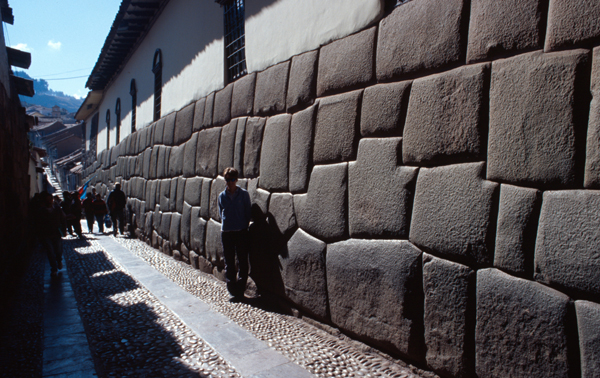Cuzco, Machu Picchu and the Inca Trail

Inca stonework, Cuzco street
CUZCO
The former capital of the Inca Empire, Cuzco is one of the world's most fascinating cities. Many ruins from the days before the Spanish conquest of Peru are still visible in the city and surrounding foothills. There are countless examples of the Incas incredible skill as stone-masons. Huge granite blocks fit so well that a knife cannot be inserted between them. There are also some beautiful buildings in the city that were built by the early Spanish colonists, including the Cathedral and buildings around the main square.
There are many fascinating things to see and do in and around Cuzco. The highlight for many will be the ruins of the magnificent toothed fortress of Sacsayhuaman which sits on a hillside above the city and is a rival even to Machu Picchu. There are also many interesting markets both in Cuzco and nearby towns like Pisac and Ollantaytambo.
MACHU PICCHU
Machu Picchu (pictured below) was rediscovered by Hiram Bingham early last century when he was looking for a fabled 'lost' Inca city in the deep valleys around Cuzco. This is the most famous ruin in South America and not without reason. The setting is superb. Machu Picchu sits on a mountain ridge, high above the deep gorge of the river Urubamba and surrounded by thick forests. The ruins themselves are extensive with many houses, temples and fortifications. We could fill a whole dossier just describing the ruins but it wouldn't do them justice - it's better just to go and see them yourself. The exact reason the Incas built Machu Picchu is not known (because they left no written records) but it was clearly a site of ceremonial importance.

The classic view of Machu Picchu from near the gate of the sun, Intipuncu
THE INCA TRAIL TO MACHU PICCHU
The most spectacular way to arrive at Machu Picchu is undoubtedly the way the Incas designed the city to be approached. The Inca Trail to Machu Picchu is a four day walk along beautifully engineered Inca 'roads' crossing several high passes up to 4200m above sea level. The Inca 'roads' include long flights of steps, traverses above deep ravines and tunnels cut through solid rock. On the way to Machu Picchu the scenery becomes increasingly spectacular with views to Salcantay and other snow capped peaks. The trail also passes many impressive ruins from the time of the Incas, some still half hidden in the thick forest. On the very last day you get our first view of Machu Picchu from the pass known as Intipuncu - the Gateway of the Sun.
Sadly due to pressure of visitor numbers a quota system is now in place and it is not possible to trek the trail alone or in a small group. The cost is now at least several hundred dollars per person, but now the trail and campsites are kept in a better state than they were. All bookings must now be made through a licensed operator and you'll need to book up to 3 or even 6 months ahead to get a place.
Cuzco area Factfile
When to go - The best season to visit is the dry season from May to September.
Weather - Cool to warm, with sunny mornings and afternoon storms common. Cold at nights, paricularly in june and July.
Flights - From London to Cuzco via Lima cost from £1000
Guidebooks - Several guidebooks feature the Inca trail and other treks in the region.

